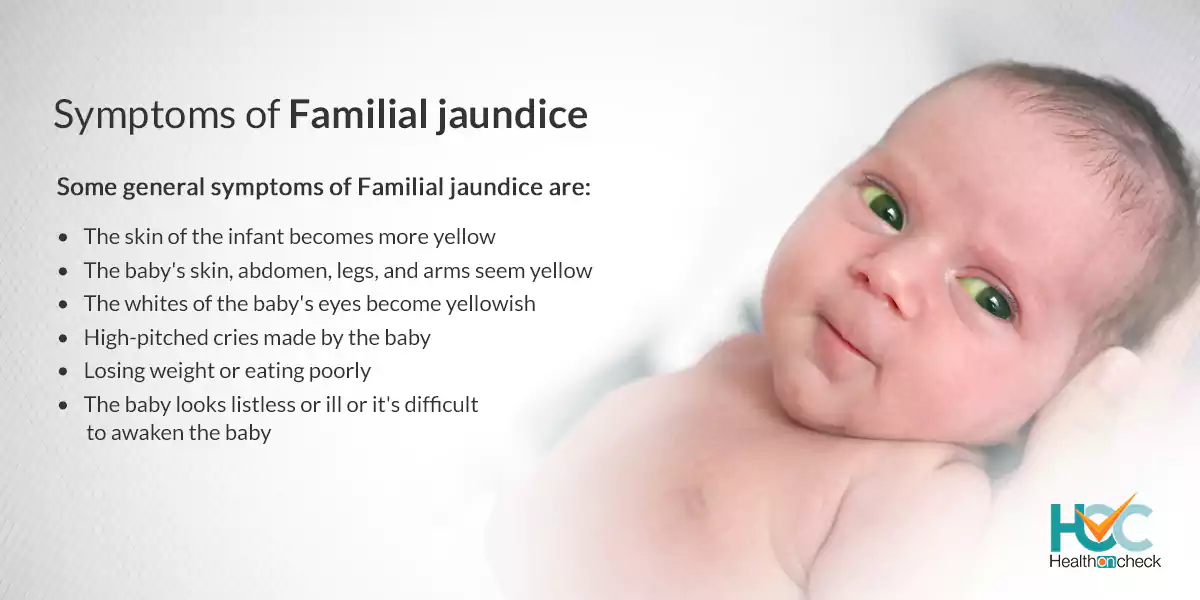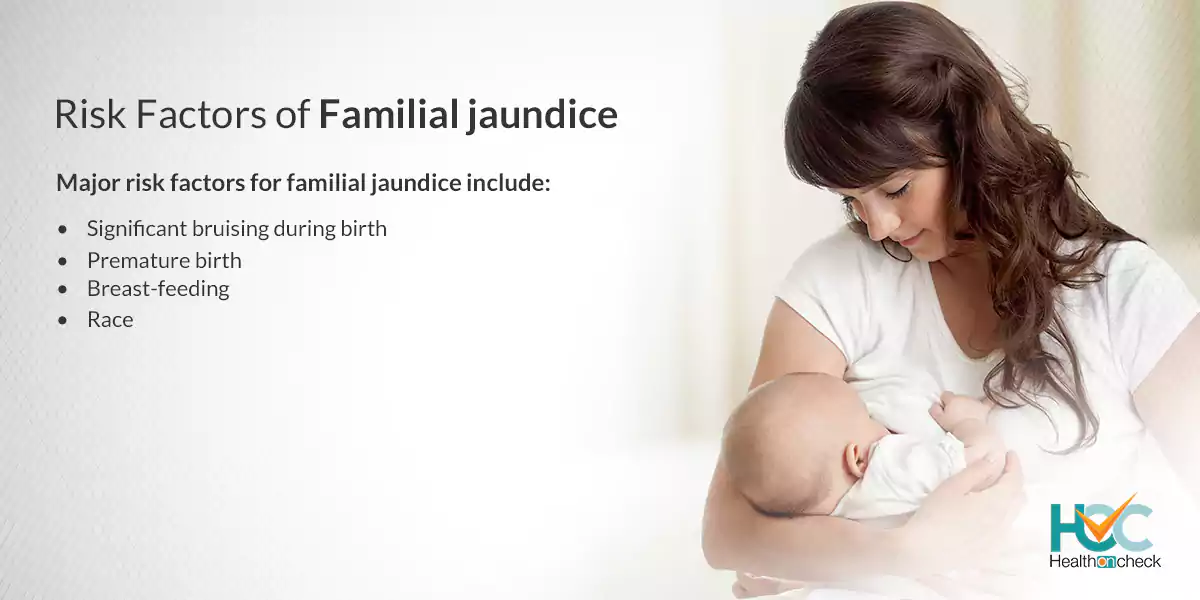All about Familial Jaundice

What is Familial Jaundice?
Familial jaundice occurs when a yellow discoloration of an infant happens to the baby’s skin and eyes. It happens due to a baby’s blood contains an additional amount, of a yellow pigment of red blood cells. This condition is not rare, especially in babies born before 8 months of pregnancy and some breastfed babies. In infants, it mostly occurs due to the baby’s liver isn’t developed enough to remove the bilirubin in the bloodstream. In a few babies, some other diseases may cause infant jaundice. This condition is not so serious and mostly fades away in one month. But the doctor needs to examine them for jaundice. Severe familial jaundice can result in brain damage if not treated properly.
What are the types of Familial jaundice?
Physiological jaundice: Physiological jaundice is the most common type of famiial jaundice in newborns is physiological jaundice and it’s a normal kind of jaundice among babies. Physiological jaundice occurs among infants on the second or third day of their life. When the liver of the baby develops, it will begin to remove additional bilirubin. Physiological jaundice usually isn’t serious and goes -away on its own within two weeks.
Breastfeeding jaundice: Familial jaundice is quite common among breastfed babies compared to formula-fed babies. Breastfeeding jaundice frequently occurs regularly in the baby’s first week of life. This condition arises when the baby is not getting adequate breast milk. It happens because of nursing problems or because the milk of the mother didn’t come in yet. Breastfeeding jaundice takes a good amount of time to go away.
Breast milk jaundice: Breast milk jaundice and breastfeeding jaundice are different. Elements in a mother’s breast milk can cause the baby’s liver breaks down bilirubin and may lead to a bilirubin buildup. It may happen after the baby’s first week of life and takes a couple of weeks or more to fade away.
What are the Symptoms of Familial jaundice?
The main symptoms include yellowing of the skin along with the whites of the eyes. Symptoms normally arise during the second and fourth day after birth. To detect Familial jaundice, gently press on the baby’s forehead or nose and if the skin seems yellow where you pressed, it’s likely your baby has mild jaundice. When the level of bilirubin augments, the yellowing usually spreads your baby’s chest, arms, legs, and belly (abdomen).

Some general symptoms of Familial jaundice are:
- The skin of the infant becomes more yellow
- The baby’s skin, abdomen, legs, and arms seem yellow
- The whites of the baby’s eyes become yellowish
- The baby looks listless or ill or it’s difficult to awaken the baby
- Losing weight or eating poorly
- High-pitched cries made by the baby
What are the Causes of Familial jaundice?
Newborns produce more bilirubin than adults do because of greater production and faster breakdown of red blood cells in the first few days of life. Normally, the liver filters bilirubin from the bloodstream and releases it into the intestinal tract. A newborn’s immature liver often can’t remove bilirubin quickly enough, causing an excess of bilirubin. Jaundice due to these normal newborn conditions is called physiologic jaundice, and it typically appears on the second or third day of life.
Other causes include:
- Infection in blood.
- Excessive amount of red blood cells
- Hypoxia
- Biliary atresia which is a liver condition.
- Bleeding internally (hemorrhage)
- Bacterial infections by viruses or bacteria
- The mother’s blood and the baby’s blood are incompatible
- Malfunction in
- An enzyme deficiency
What are the Risk Factors of Familial jaundice?
Major risk factors for familial jaundice include:
Premature birth: If a baby is born before 38 weeks of gestation won’t be capable to process bilirubin as rapidly as normal babies do. Premature babies are low in feeling with fewer bowel movements, which leads to less bilirubin removed via stool.
Significant bruising during birth: Infants who get bruised during delivery receive bruises from delivery may have larger levels of bilirubin from the malfunction of more red blood cells.
Blood type: When a mother’s blood type varies from her baby’s, the baby may get antibodies through the placenta that lead to an abnormally fast breakdown of red blood cells.
Breast-feeding: Babies who are breastfeeding, especially those who face difficulty while nursing or getting sufficient nutrition are at higher risk of getting familial jaundice. Dehydration or a low caloric intake can also jaundice.
Race: Babies of East Asian ancestry are at higher risk of familial jaundice

What are the Complications of Familial jaundice?
The Complications of Familial jaundice include:
- Lackadaisical
- Problems in waking
- High-pitched crying by the baby
- Less feeding or sucking
- The neck and body getting backward arch
- Fever
How to Diagnose Familial jaundice?
The diagnosis of familial jaundice is based on your baby’s appearance. But it’s vital to check the level of bilirubin in the baby’s blood. The level of severity of jaundice will pave way for the course of treatment. Tests to diagnose jaundice include:
- Physical exam by a doctor
- Blood test
- A skin test with a device called a transcutaneous bilirubin meter is used to measure the reflection of a special light passed through the skin
- The doctor may advise you to go for some extra blood tests or urine tests to check that the baby’s jaundice is caused by an underlying disease.
What are the Treatment Options Available for Familial jaundice?
Some common treatments available for Familial jaundice are:
Enhanced nutrition: To stop weight loss, a doctor can ask for more regular feeding or augmentation, to make sure that the baby gets a good amount of nutrition.
Hototherapy: A special lamp that emits light in the blue-green spectrum can be placed under a special lamp. The shape and structure of bilirubin molecules are changed by light in a way that both of them can be excreted in the urine and stool. During the treatment only a diaper and protective eye patches, the baby will wear.
Exchange transfusion: Exchange transfusion is used when the other treatments are not responded to. The baby may require a change in the transfusion of blood. It entails frequently withdrawing a small volume of blood and changing it with the blood of the donor, therefore weakening the bilirubin and maternal antibodies and it’s a procedure that’s carried out in an infant intensive care unit.
Living with Familial jaundice
Familial jaundice is not problematic in most periods. A huge number of babies, with this jaundice, will get well with no need for treatment within 1 to 2 weeks. The color of the eyes becomes yellow. For infants and babies, who are at risk of getting Familial jaundice, it may take time of 5 to 7 days to appear and generally lasts about one month.
Whom to Consult?
If you notice signs and symptoms of your baby then the baby should be diagnosed with familial jaundice between the third and seventh-day post-birth, when bilirubin levels normally shoot up. If the baby has jaundice, then you should immediately start the treatment after consulting with a doctor.




